-
Visual Studio 2019下使用C++与Python进行混合编程——环境配置与C++调用Python API接口
前言
- 在vs2019下使用C++与Python进行混合编程,在根源上讲,Python 本身就是一个C库,那么这里使用其中最简单的一种方法是把Python的C API来嵌入C++项目中,来实现混合编程。
- 当前的环境是,win10,IDE是vs2019,python版本是3.9,python的环境是使用Anacond安装的。
一、环境配置
1. 安装Python
首先要安装好Python的库,Python可以直接从官网下载,或者直接在conda里面进行安装。2.添加环境变量
安装完成之后,添加两个系统环境变量,分别是:PYTHONHOME和PYTHONPATH。
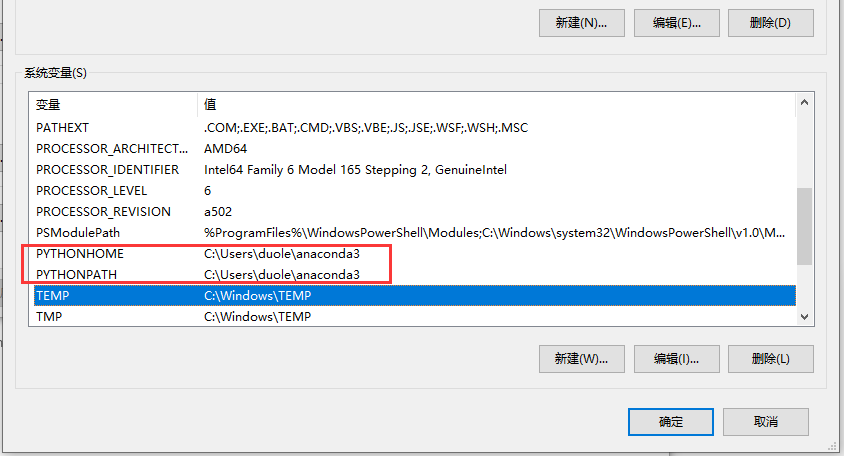
如果不添加这两个系统环境变量会报以下的错误:Python path configuration: PYTHONHOME = (not set) PYTHONPATH = (not set) program name = 'python' isolated = 0 environment = 1 user site = 1 import site = 1 sys._base_executable = 'C:\\code\\cpp\\PDFToDoc\\x64\\Release\\PDFToDoc.exe' sys.base_prefix = 'C:\\Users\\duole\\anaconda3' sys.base_exec_prefix = 'C:\\Users\\duole\\anaconda3' sys.platlibdir = 'lib' sys.executable = 'C:\\code\\cpp\\PDFToDoc\\x64\\Release\\PDFToDoc.exe' sys.prefix = 'C:\\Users\\duole\\anaconda3' sys.exec_prefix = 'C:\\Users\\duole\\anaconda3' sys.path = [ 'C:\\Users\\duole\\anaconda3\\python39.zip', '.\\DLLs', '.\\lib', 'C:\\code\\cpp\\PDFToDoc\\x64\\Release', ] Fatal Python error: init_fs_encoding: failed to get the Python codec of the filesystem encoding Python runtime state: core initialized ModuleNotFoundError: No module named 'encodings' Current thread 0x000042d4 (most recent call first): <no Python frame>- 1
- 2
- 3
- 4
- 5
- 6
- 7
- 8
- 9
- 10
- 11
- 12
- 13
- 14
- 15
- 16
- 17
- 18
- 19
- 20
- 21
- 22
- 23
- 24
- 25
- 26
- 27
3. 创建项目
打开vs2019,创建一个空的新C++项目:

创建完成后打开项目属于配置包含目录与库目录:
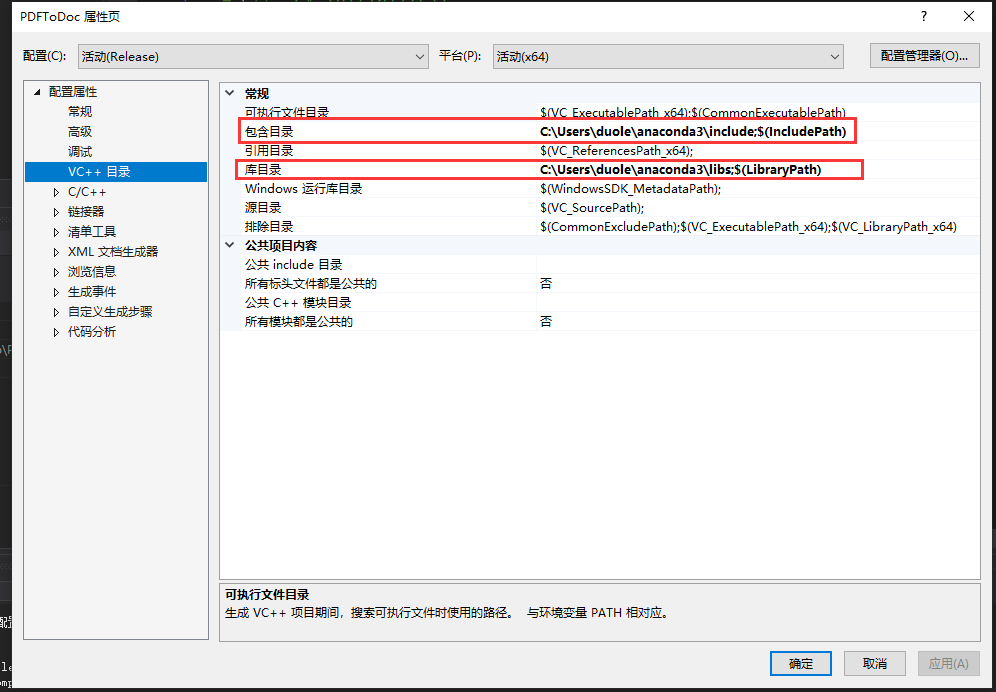
在附加依赖项目里把python的lib库名添加到里面:
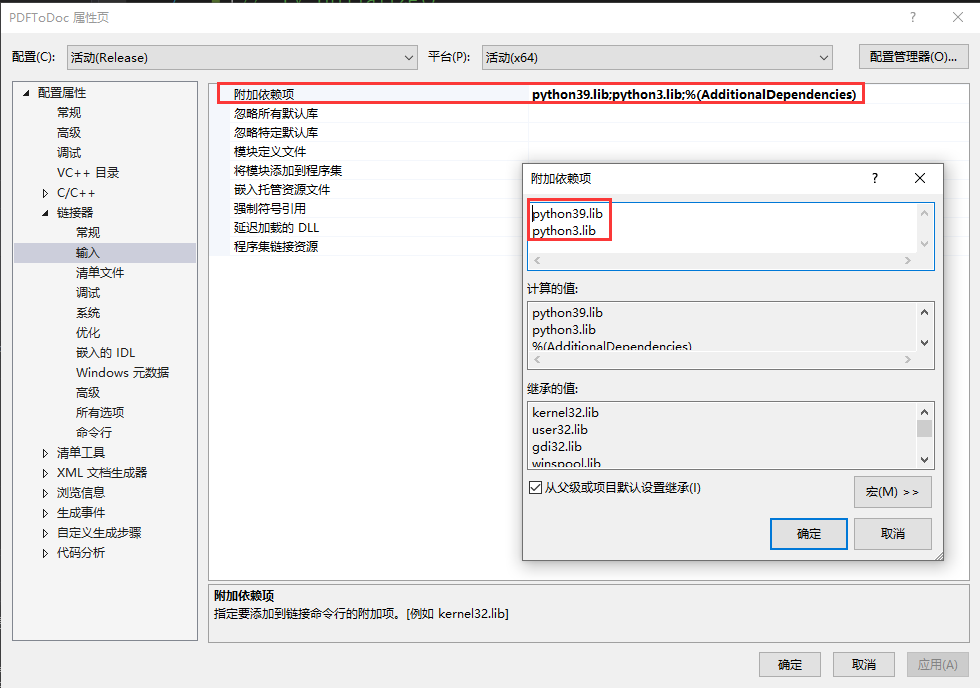
4.添加代码
在项目里面新添一个main.cpp
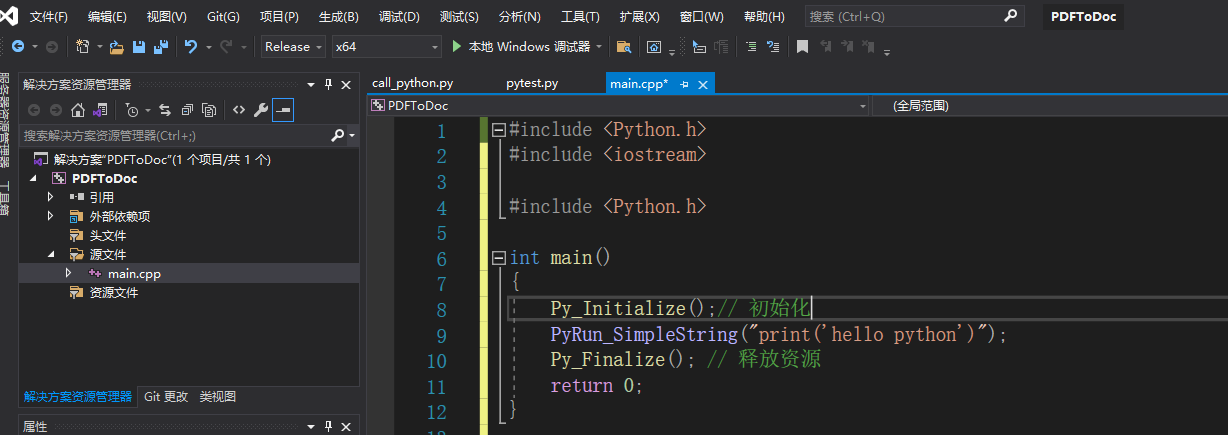
main.cpp里面的代码:#includeint main() { Py_Initialize(); // 初始化python解释器 PyRun_SimpleString("print('hello python')"); Py_Finalize(); // 释放资源 return 0; } - 1
- 2
- 3
- 4
- 5
- 6
- 7
- 8
- 9
然后运行项目
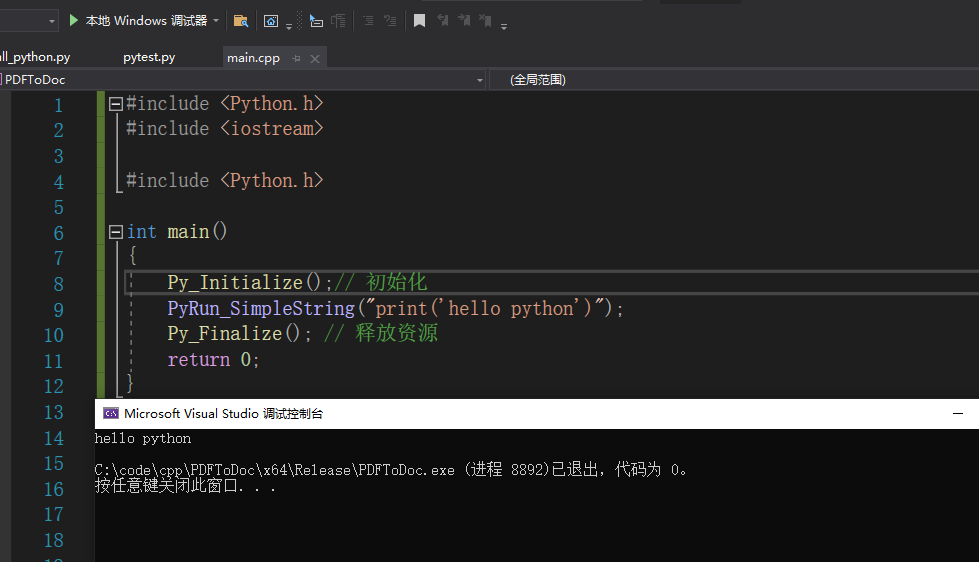
这样配置就算法成功了。二、Python C API 调用
为了方便项目测试,在项目根目录下添加一个script目录,在script目录里面创建一个call_python.py的文件。

2.1 调用Python代码无参函数
C++调用python无参函数流程:
- 初始化python接口(Py_Initialize)
- 导入依赖库 (PyRun_SimpleString)
- 初始化python系统文件路径(PyRun_SimpleString)
- 调用python文件名(PyImport_ImportModule)
- 获取函数对象(PyObject_GetAttrString)
- 调用函数对象(PyObject_CallObject)
- 结束python接口调用,释放资源(Py_Finalize)
在call_python.py里面添加代码:
def test(): print("hello python to C++")- 1
- 2
然后在main.cpp里面进行调用:
int main() { //1.初始化python接口 Py_Initialize(); if (!Py_IsInitialized) { std::cout << "python init failed" << std::endl; return 1; } //2.导入依赖库 PyRun_SimpleString("import sys");//执行py单条语句 //3.初始化python系统文件路径,以便访问到python源码文件所在的路径 PyRun_SimpleString("sys.path.append('./script')"); //4.调用python源码文件,只写文件名,不用写后缀 PyObject* module = PyImport_ImportModule("call_python"); if (module == nullptr) { std::cout << "module not found: call_python" << std::endl; return 1; } //5.获取python文件里面的函数 PyObject* test = PyObject_GetAttrString(module, "test"); if (!test || !PyCallable_Check(test)) { std::cout << "function not found: test" << std::endl; return 1; } //6.调用函数,函数对象与传入参数 PyObject_CallObject(test, nullptr); Py_Finalize(); return 0; }- 1
- 2
- 3
- 4
- 5
- 6
- 7
- 8
- 9
- 10
- 11
- 12
- 13
- 14
- 15
- 16
- 17
- 18
- 19
- 20
- 21
- 22
- 23
- 24
- 25
- 26
- 27
- 28
- 29
- 30
- 31
- 32
- 33
- 34
- 35
- 36
- 37
- 38
- 39
- 40
- 41
- 42
2.2 调用Python代码有参与有返回值的函数
C++调用python有参并有返回的函数流程:
- 初始化python接口(Py_Initialize)
- 导入依赖库 (PyRun_SimpleString)
- 初始化python系统文件路径(PyRun_SimpleString)
- 调用python文件名(PyImport_ImportModule)
- 获取函数对象(PyObject_GetAttrString)
- 传递参数(PyTuple_New,Py_BuildValue)
- 调用函数对象(PyObject_CallObject)
- 接收函数返回值(PyArg_Parse)
- 结束python接口初始化(Py_Finalize)
在call_python.py里面添加代码:
def add(a, b): c = a + b print(f"{a} + {b} = {c}") return c- 1
- 2
- 3
- 4
然后在main.cpp里面进行调用:
#include#include int main() { // 1、初始化python接口 Py_Initialize(); if (!Py_IsInitialized()) { std::cout << "python init failed" << std::endl; return 1; } // 2、初始化python系统文件路径,保证可以访问到 .py文件 PyRun_SimpleString("import sys"); PyRun_SimpleString("sys.path.append('./script')"); // 3、调用python文件名,不用写后缀 PyObject* module = PyImport_ImportModule("call_python"); if (module == nullptr) { std::cout << "module not found: call_python" << std::endl; return 1; } // 4、调用函数 PyObject* func = PyObject_GetAttrString(module, "add"); if (!func || !PyCallable_Check(func)) { std::cout << "function not found: add" << std::endl; return 1; } // 5、给 python 传递参数 // 函数调用的参数传递均是以元组的形式打包的, 2表示参数个数 // 如果函数中只有一个参数时,写1就可以了 PyObject* args = PyTuple_New(2); // 0:第一个参数,传入 int 类型的值 1 PyTuple_SetItem(args, 0, Py_BuildValue("i", 1)); // 1:第二个参数,传入 int 类型的值 2 PyTuple_SetItem(args, 1, Py_BuildValue("i", 2)); // 6、使用C++的python接口调用该函数 PyObject* ret = PyObject_CallObject(func, args); // 7、接收python计算好的返回值 int result; // i表示转换成int型变量。 // 在这里,最需要注意的是:PyArg_Parse的最后一个参数,必须加上“&”符号 PyArg_Parse(ret, "i", &result); std::cout << "return is " << result << std::endl; // 8、结束python接口初始化 Py_Finalize(); return 0; } - 1
- 2
- 3
- 4
- 5
- 6
- 7
- 8
- 9
- 10
- 11
- 12
- 13
- 14
- 15
- 16
- 17
- 18
- 19
- 20
- 21
- 22
- 23
- 24
- 25
- 26
- 27
- 28
- 29
- 30
- 31
- 32
- 33
- 34
- 35
- 36
- 37
- 38
- 39
- 40
- 41
- 42
- 43
- 44
- 45
- 46
- 47
- 48
- 49
- 50
- 51
- 52
- 53
- 54
- 55
- 56
Py_BuildValue()函数的作用和PyArg_ParseTuple()的作用相反,它是将C类型的数据结构转换成Python对象,该函数的原型:
PyObject *Py_BuildValue(char *format, …)
该函数可以和PyArg_ParseTuple()函数一样识别一系列的格式串,但是输入参数只能是值,而不能是指针。它返回一个Python对象。
和PyArg_ParseTuple()不同的一点是PyArg_ParseTuple()函数它的第一个参数为元组,Py_BuildValue()则不一定会生成一个元组。它生成一个元组仅仅当格式串包含两个或者多个格式单元,如果格式串为空,返回NONE。
在下面的描述中,括号中的项是格式单元返回的Python对象类型,方括号中的项为传递的C的值的类型。
“s” (string) [char *] :将C字符串转换成Python对象,如果C字符串为空,返回NONE。
“s#” (string) [char *, int] :将C字符串和它的长度转换成Python对象,如果C字符串为空指针,长度忽略,返回NONE。
“z” (string or None) [char *] :作用同"s"。
“z#” (string or None) [char *, int] :作用同"s#“。
“i” (integer) [int] :将一个C类型的int转换成Python int对象。
“b” (integer) [char] :作用同"i”。
“h” (integer) [short int] :作用同"i"。
“l” (integer) [long int] :将C类型的long转换成Pyhon中的int对象。
“c” (string of length 1) [char] :将C类型的char转换成长度为1的Python字符串对象。
“d” (float) [double] :将C类型的double转换成python中的浮点型对象。
“f” (float) [float] :作用同"d"。
“O&” (object) [converter, anything] :将任何数据类型通过转换函数转换成Python对象,这些数据作为转换函数的参数被调用并且返回一个新的Python对象,如果发生错误返回NULL。
“(items)” (tuple) [matching-items] :将一系列的C值转换成Python元组。
“[items]” (list) [matching-items] :将一系列的C值转换成Python列表。
“{items}” (dictionary) [matching-items] :将一系类的C值转换成Python的字典,每一对连续的C值将转换成一个键值对。2.3 调用Python类
C++调用python类流程:
- 初始化python接口(Py_Initialize)
- 初始化python系统文件路径(PyRun_SimpleString)
- 调用python文件名(PyImport_ImportModule)
- 获取类(PyObject_GetAttrString)
- 根据类构造函数实例化对象(PyEval_CallObject)
- 获取实例的函数对象(PyObject_GetAttrString)
- 传递参数(PyTuple_New,Py_BuildValue)
- 调用函数对象(PyObject_CallObject)
- 接收函数返回值(PyArg_Parse)
- 结束python接口初始化(Py_Finalize)
在call_python.py里面添加代码:
class Person: def __init__(self, name, age): self.name = name self.age = age def foo(self): print(f"my name is {self.name}, my age is {self.age}")- 1
- 2
- 3
- 4
- 5
- 6
- 7
- 8
然后在main.cpp里面进行调用:
#include#include int main() { // 1、初始化python接口 Py_Initialize(); if (!Py_IsInitialized()) { std::cout << "python init failed" << std::endl; return 1; } // 2、初始化python系统文件路径,保证可以访问到 .py文件 PyRun_SimpleString("import sys"); PyRun_SimpleString("sys.path.append('./script')"); // 3、调用python文件名,不用写后缀 PyObject* module = PyImport_ImportModule("call_python"); if (module == nullptr) { std::cout << "module not found: call_python" << std::endl; return 1; } // 4、获取类 PyObject* cls = PyObject_GetAttrString(module, "Person"); if (!cls) { std::cout << "class not found: Person" << std::endl; return 1; } // 5、给类构造函数传递参数 // 函数调用的参数传递均是以元组的形式打包的, 2表示参数个数 // 如果函数中只有一个参数时,写1就可以了 PyObject* args = PyTuple_New(2); // 0:第一个参数,传入 int 类型的值 1 PyTuple_SetItem(args, 0, Py_BuildValue("s", "jack")); // 1:第二个参数,传入 int 类型的值 2 PyTuple_SetItem(args, 1, Py_BuildValue("i", 18)); // 6、根据类名实例化对象 PyObject* obj = PyObject_CallObject(cls, args); // 7、根据对象得到成员函数 PyObject* func = PyObject_GetAttrString(obj, "foo"); if (!func || !PyCallable_Check(func)) { std::cout << "function not found: foo" << std::endl; return 1; } // 8、使用C++的python接口调用该函数 PyObject_CallObject(func, nullptr); // 9、结束python接口初始化 Py_Finalize(); return 0; } - 1
- 2
- 3
- 4
- 5
- 6
- 7
- 8
- 9
- 10
- 11
- 12
- 13
- 14
- 15
- 16
- 17
- 18
- 19
- 20
- 21
- 22
- 23
- 24
- 25
- 26
- 27
- 28
- 29
- 30
- 31
- 32
- 33
- 34
- 35
- 36
- 37
- 38
- 39
- 40
- 41
- 42
- 43
- 44
- 45
- 46
- 47
- 48
- 49
- 50
- 51
- 52
- 53
- 54
- 55
- 56
- 57
- 58
- 59
- 60
-
相关阅读:
解析边缘计算网关的优势-天拓四方
【进阶版】 机器学习分类算法之XGBoost(集成学习算法)、LightGBM(梯度提升框架)(13)
Lua使用三目运算符取值
从内核世界透视 mmap 内存映射的本质(原理篇)
并发包锁实现的精髓----队列同步器(AbstractQueuedSynchronizer)
Fluent Bit组件同时搜集多种可观测性数据
在Java中访问并配置环境变量
Vue Router 源码分析
为什么我的视频播放量上不去?
班级新闻管理系统asp.net+sqlserver
- 原文地址:https://blog.csdn.net/matt45m/article/details/132761794